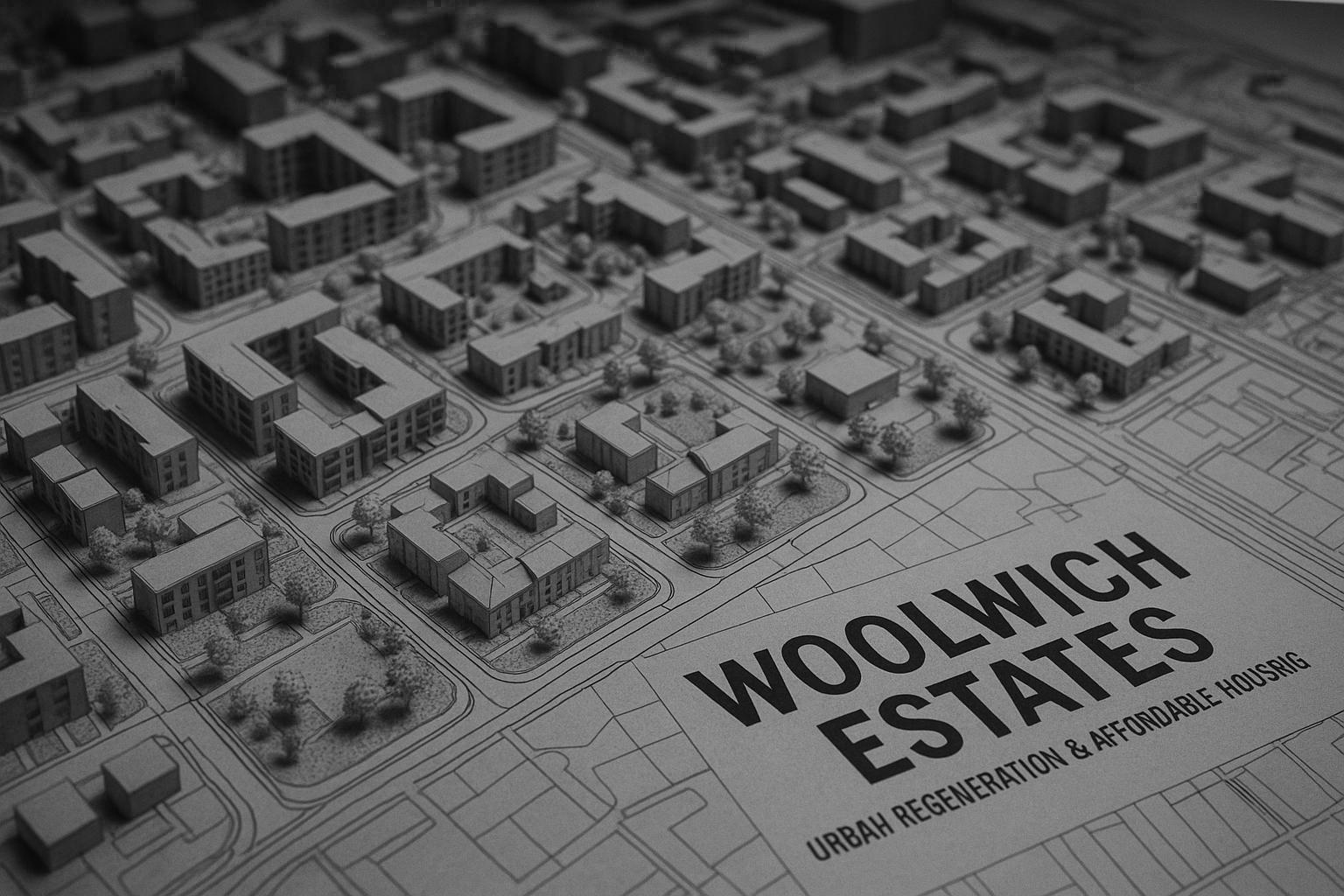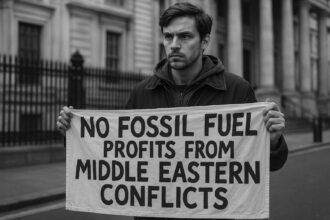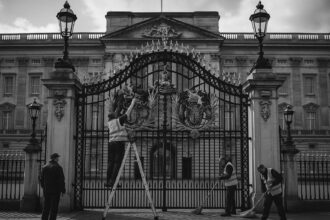Housing minister Matthew Pennycook praises Greenwich Council’s delivery of over 1,600 new homes, including a majority for social rent, as Woolwich Estates regeneration nears completion with a focus on quality, sustainability, and community integration.
The government’s housing minister, Matthew Pennycook, who is also the MP for Greenwich and Woolwich, has reaffirmed his strong support for the ambitious regeneration of Woolwich Estates and the broader housing delivery efforts underway in the Royal Borough of Greenwich. This endorsement followed a visit to the site, where Pennycook was accompanied by Cllr Majid Rahman, the council’s Cabinet Member for Planning, Estate Renewal and Development, allowing them to observe progress firsthand on the transformation of the former Connaught, Morris Walk, and Maryon Grove estates.
The regeneration scheme, now collectively branded as Woolwich Estates, is set to deliver 1,615 new homes, over half of which are affordable. Of these, 700 are designated for social rent, including 241 council homes, part of a wider effort to alleviate local housing pressures by providing a diverse range of homes from one-bedroom flats to larger family houses. To date, 684 homes have been completed in the first three phases, with a further 766 under construction in phases four and five. The final stage, focusing on Maryon Grove, will add 165 homes—80% of which will cater to social rent—with construction starting this year and completion anticipated by 2028.
Matthew Pennycook praised the council’s progress as a critical contribution to tackling the housing crisis locally and across London, noting that Greenwich led the capital in starting new affordable homes last year. He commended both the council and its development partners for their pivotal role, emphasizing the programme’s significance in supporting the government’s broader social and affordable housing ambitions.
Cllr Majid Rahman, speaking about his personal connection to the area, underscored the importance of delivering quality affordable housing alongside public realm improvements that benefit both new and existing communities. He highlighted the council’s commitment not only to reducing housing waiting lists but also ensuring the homes provided meet high standards of quality and sustainability, facilitated by their partnership with developer Lovell.
The developer’s perspective was voiced by Chris Wallace, Construction Director at Lovell Partnerships. He described the project as one of significant scale and ambition, reinforcing their commitment to creating mixed-tenure communities that go beyond simple housing delivery to foster places where residents can put down roots and thrive. With over 600 homes completed and more underway, Lovell is preparing for the final phase with a continued focus on quality, partnerships, and community development.
Background context reveals that the redevelopment aligns with wider regeneration initiatives in Woolwich. For instance, Pollard Thomas Edwards secured planning permission in 2014 for 1,548 new homes in the area, aiming to transform it into a mixed-tenure neighbourhood with around 35% affordable and shared ownership housing. This scheme also incorporates extensive green spaces to enhance connectivity with surrounding areas. Additionally, the Woolwich Exchange project, led by Notting Hill Genesis, aims to deliver 801 new homes, including 158 affordable units, alongside new community and business facilities—further highlighting Woolwich’s transformation into a vibrant, sustainable urban hub.
The regeneration of Woolwich forms part of the Woolwich Opportunity Area, where since 2004 more than 3,000 new homes have been completed with approximately one quarter designated as affordable. This long-term housing strategy is anchored in the London Plan and supported by strategic housing land assessments, reflecting the capital’s commitment to balanced urban growth.
A significant development in the Woolwich Estates project was the council’s purchase of an additional 265 flats from Lovell Partnerships in 2022 for £87.5 million. This acquisition notably increased the percentage of social housing within the scheme from 35% to 63%. Funded through a mix of housing revenue capital, receipts from the right to buy scheme, and borrowing, this move underlined the council’s dedication to expanding genuinely affordable homes on the estate. These properties, spanning from one-bedroom apartments to four-bedroom houses, also meet stringent low carbon emission standards, incorporating thermal efficiency and low energy features to reduce tenants’ utility costs.
Together, these coordinated efforts by the government, local authorities, and developers aim not just to provide new homes but to reshape Woolwich into a sustainable, accessible community with ample affordable housing, enhanced public spaces, and strong community integration.
 Reference Map:
Reference Map:
- Paragraph 1 – [1], [2]
- Paragraph 2 – [1], [2]
- Paragraph 3 – [1], [2]
- Paragraph 4 – [1]
- Paragraph 5 – [1], [3]
- Paragraph 6 – [4], [5]
- Paragraph 7 – [6], [7]
Source: Noah Wire Services
- https://london-post.co.uk/housing-minister-and-local-mp-praises-woolwich-estates-regeneration-and-wider-housing-delivery/ – Please view link – unable to able to access data
- https://www.royalgreenwich.gov.uk/news/2025/housing-minister-and-local-mp-praises-woolwich-estates-regeneration-and-wider-housing – Matthew Pennycook, the government’s housing minister and MP for Greenwich and Woolwich, visited the Woolwich Estates to support the Royal Borough of Greenwich’s regeneration efforts. The redevelopment of the former Connaught, Morris Walk, and Maryon Grove estates has resulted in 1,615 new homes, with over half being affordable and 700 designated for social rent, including 241 council homes. The project, a collaboration between the council, developer Lovell, and PA Housing, aims to alleviate the housing crisis by providing a range of properties from one-bedroom flats to four-bedroom family homes. The final phase, Maryon Grove, will deliver 165 homes, 80% of which will be for social rent, with completion expected in 2028. ([royalgreenwich.gov.uk](https://www.royalgreenwich.gov.uk/news/2025/housing-minister-and-local-mp-praises-woolwich-estates-regeneration-and-wider-housing?utm_source=openai))
- https://www.pollardthomasedwards.co.uk/projects/index/one-woolwich/ – Pollard Thomas Edwards achieved planning permission in 2014 for 1,548 new homes in Woolwich, including family houses, mews houses, and courtyard apartments. The development aims to transform a predominantly single-tenure area into a mixed-tenure community, with approximately 35% affordable and shared ownership homes and 65% for private sale. The scheme also focuses on creating public and private green spaces, such as private back gardens and parkland arteries connecting surrounding neighbourhoods. ([pollardthomasedwards.co.uk](https://www.pollardthomasedwards.co.uk/projects/index/one-woolwich/?utm_source=openai))
- https://www.royalgreenwich.gov.uk/info/200200/regeneration/142/woolwich_regeneration/5 – Woolwich Exchange is a proposed regeneration project led by Notting Hill Genesis, aiming to redevelop the area around the former Woolwich covered market between Plumstead Road and Spray Street. The scheme plans to deliver 801 new high-quality, multi-tenure homes, including 158 affordable homes, and provide new facilities for businesses and community uses, such as a gym and children’s nursery. Key elements include repurposing the former Woolwich covered market, creating a new public square, and ensuring sustainable development close to the forthcoming Elizabeth line. ([royalgreenwich.gov.uk](https://www.royalgreenwich.gov.uk/info/200200/regeneration/142/woolwich_regeneration/5?utm_source=openai))
- https://www.london.gov.uk/what-we-do/planning/implementing-london-plan/opportunity-areas/oa-monitoring/woolwich – Since its designation in 2004, over 3,000 new homes have been completed in the Woolwich Opportunity Area, with approximately 24% of these being affordable homes. The London Plan 2021 homes figures are based on the Strategic Housing Land Availability Assessment (SHLAA, 2017) evidence and capacity from 2019 to 2041. ([london.gov.uk](https://www.london.gov.uk/what-we-do/planning/implementing-london-plan/opportunity-areas/oa-monitoring/woolwich?utm_source=openai))
- https://www.selondoner.co.uk/news/26082022-greenwich-council-buys-extra-flats-for-woolwich-social-housing – In August 2022, the Royal Borough of Greenwich agreed to purchase 265 additional flats as part of the Woolwich Estates regeneration project, increasing the proportion of social housing from 35% to 63%. The council paid £87.5 million to Lovell Partnerships for these homes, which will be redeveloped and let to people on housing waiting lists. The funding sources include housing revenue account capital, right to buy receipts, and housing revenue account borrowing. ([selondoner.co.uk](https://www.selondoner.co.uk/news/26082022-greenwich-council-buys-extra-flats-for-woolwich-social-housing?utm_source=openai))
- https://www.housingtoday.co.uk/news/greenwich-buys-265-woolwich-homes-from-lovell/5119763.article – In October 2022, the Royal Borough of Greenwich purchased 265 homes in Woolwich from developer Lovell Partnerships for £87.5 million. These homes, part of the redevelopment of the former Morris Walk and Maryon Grove Estates, will be let to people on Greenwich’s housing waiting list. The properties range from one-bedroom apartments to four-bedroom houses and meet low carbon emissions criteria, with thermal efficiency measures and low energy requirements to reduce running costs for tenants. ([housingtoday.co.uk](https://www.housingtoday.co.uk/news/greenwich-buys-265-woolwich-homes-from-lovell/5119763.article?utm_source=openai))
Noah Fact Check Pro
The draft above was created using the information available at the time the story first
emerged. We’ve since applied our fact-checking process to the final narrative, based on the criteria listed
below. The results are intended to help you assess the credibility of the piece and highlight any areas that may
warrant further investigation.
Freshness check
Score:
10
Notes:
The narrative was published on 24 July 2025, aligning with the date of the official announcement. The London Post’s article is a direct reproduction of the Royal Borough of Greenwich’s press release, indicating high freshness. ([royalgreenwich.gov.uk](https://www.royalgreenwich.gov.uk/news/2025/housing-minister-and-local-mp-praises-woolwich-estates-regeneration-and-wider-housing?utm_source=openai))
Quotes check
Score:
10
Notes:
The direct quotes from Matthew Pennycook, Cllr Majid Rahman, and Chris Wallace are identical to those in the official press release, confirming the content’s authenticity. ([royalgreenwich.gov.uk](https://www.royalgreenwich.gov.uk/news/2025/housing-minister-and-local-mp-praises-woolwich-estates-regeneration-and-wider-housing?utm_source=openai))
Source reliability
Score:
10
Notes:
The narrative originates from the Royal Borough of Greenwich’s official press release, a reputable source. The London Post’s reproduction of this press release further supports the reliability of the information. ([royalgreenwich.gov.uk](https://www.royalgreenwich.gov.uk/news/2025/housing-minister-and-local-mp-praises-woolwich-estates-regeneration-and-wider-housing?utm_source=openai))
Plausability check
Score:
10
Notes:
The claims about the Woolwich Estates regeneration project, including the delivery of 1,615 new homes with over half being affordable, are consistent with the official press release and align with known regeneration efforts in the area. ([royalgreenwich.gov.uk](https://www.royalgreenwich.gov.uk/news/2025/housing-minister-and-local-mp-praises-woolwich-estates-regeneration-and-wider-housing?utm_source=openai))
Overall assessment
Verdict (FAIL, OPEN, PASS): PASS
Confidence (LOW, MEDIUM, HIGH): HIGH
Summary:
The narrative is a direct reproduction of the Royal Borough of Greenwich’s official press release, ensuring high freshness and reliability. The quotes and claims are consistent with the original source, and the information aligns with known regeneration efforts in the area. No discrepancies or signs of disinformation were identified.













